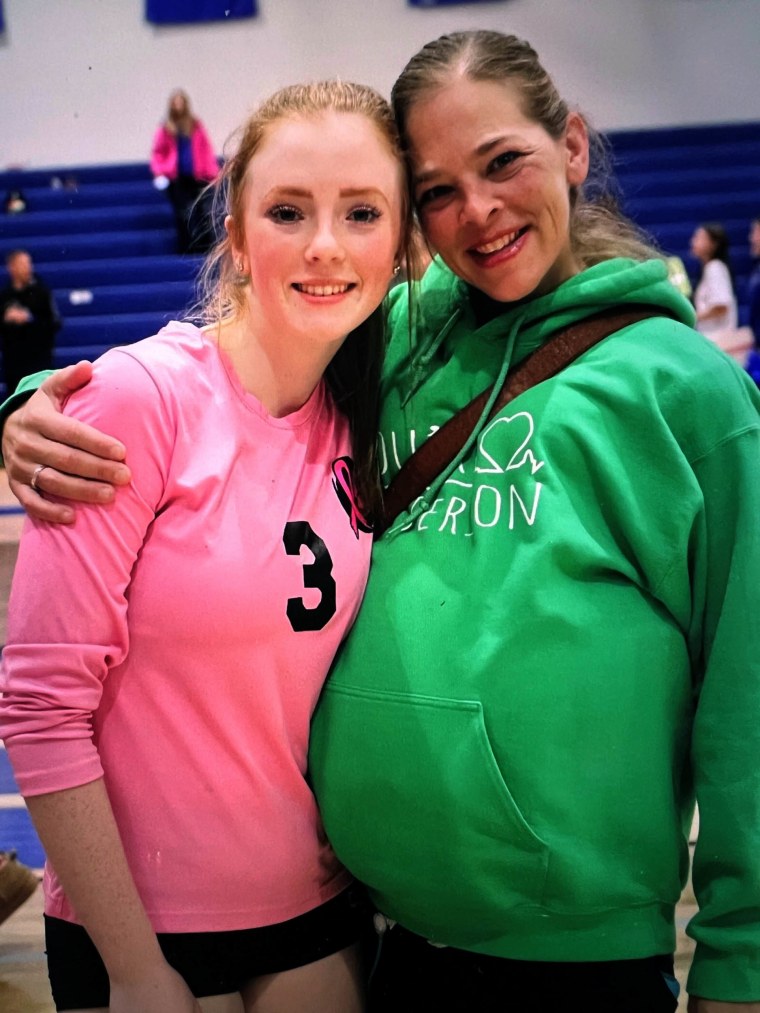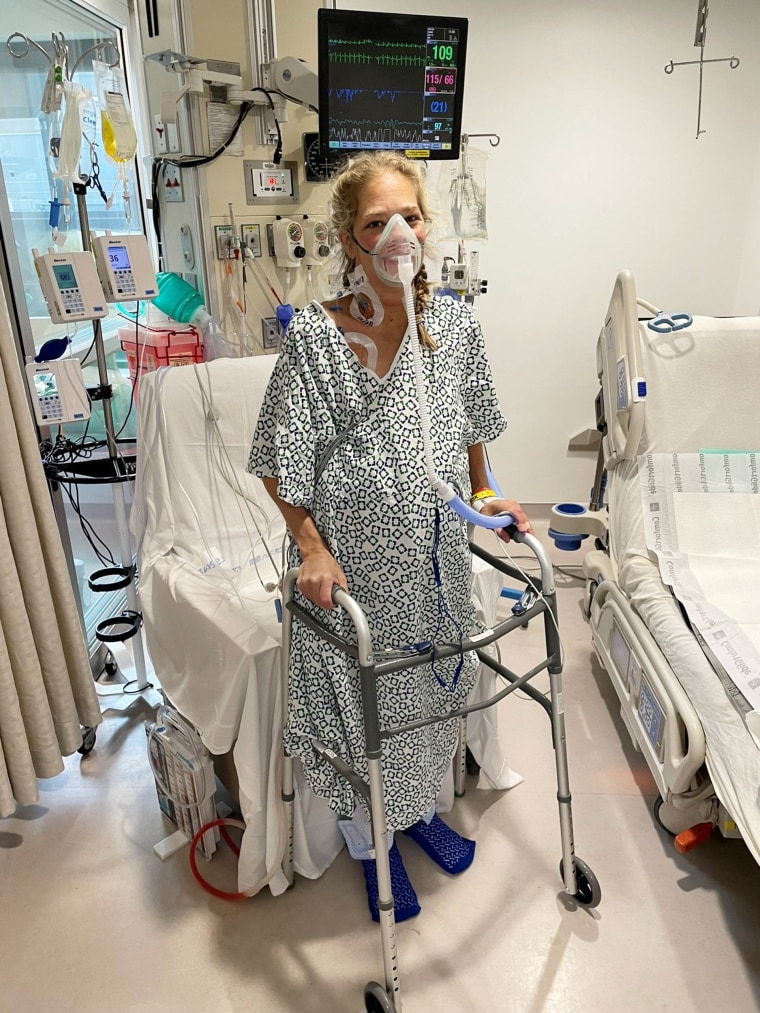More than a decade ago, Sarah Minton received life-changing news: Doctors diagnosed her with a rare blood disorder and a rare liver disease. Two years later, she was diagnosed with liver cancer and underwent radiation treatment to treat it. Minton's liver was failing.
“At that point, the doctors say, 'Okay, it's time for you to get a liver transplant,'” the 42-year-old from Laingsburg, Michigan, told TODAY.com. “I knew from the time I was first diagnosed that a transplant was going to be in my future.”
Although she had hoped to wait until later in life to receive a liver transplant, by the time she was in her late 30s, doctors knew she would need a new one soon, but she also developed lung disease, and doctors feared she would need both a liver and a double lung transplant.
“It scared me,” she said. “I wanted a second opinion.”
That second opinion transformed her health. Doctors at the Cleveland Clinic treated her lungs with medicine and had her undergo special tests to make sure she was healthy enough for a transplant. She is now enjoying life with her new liver.
“It took two years for my lungs to heal and be safe enough to be put on the transplant list,” Minton said. “At one point the doctors told me I had six months to live, and by the time I had the transplant I was four months into that.”
Blood disorders, liver diseases, cancer
In her mid-20s, Minton began struggling with complex and unusual health issues. At 26, she was diagnosed with a rare condition called Budd-Chiari syndrome, which causes blockages in the veins that carry blood away from the liver. Cleveland Clinic.
“It's a really rare disease, and even rarer when it's discovered,” she says. “It's usually seen in older men.” She was also diagnosed with a rare blood disorder called polycythemia vera, which causes the body to make too many red blood cells, thickening the blood and causing it to clot. Mayo ClinicTo address blockages in the blood vessels in his liver, Minton had stents inserted to keep the blood vessels open.
“I managed to get by for the next 10 years,” she says, “but over time my liver function deteriorated to the point where I had cancerous spots on my liver.”
Doctors “caught it very early” and administered radiation therapy, she said, but they acknowledged Minton would likely need a new liver in the near future.
“They started the workup for the transplant,” Minton says.
But doctors discovered she had pulmonary hypertension, a condition that causes high blood pressure in the lungs. National Institutes of HealthDoctors feared her “very severe” pulmonary hypertension could not be effectively treated with medication and thought she would instead require a double lung transplant.
“I needed two organs,” she said. “I was scared to death.”
Minton decided to visit the Cleveland Clinic for a second opinion, and after meeting with a number of doctors, she learned that they believed medication could help alleviate her pulmonary hypertension.
“It was a 24-hour continuous infusion through a pump,” she said. “It went into my chest and straight into my heart.”
If that worked, doctors thought Minton might be stable enough to undergo a transplant.
“It was a very long process,” she said. “It took two years for my lungs to heal and be safe enough to be put on the transplant list.”
While his lungs were recovering, Minton continued to suffer from symptoms related to his liver disease, including excessive fluid buildup in his abdomen.
“I felt like I was about eight months pregnant,” she said. “Every week I had fluid drained from my abdomen, but within a week I needed it drained again.”
Minton added that about “six to seven litres” of fluid was expelled each time.
“The luggage we carry is heavy and tiring,” she says.
Minton also required frequent blood transfusions, and the combination of frequent blood transfusions, fluid loss and general poor health made it difficult for her to manage her health and continue working.
“It happened about twice a week,” she said. “I was working, but it was hard.”
In August 2023, Minton was placed on the liver transplant list. Initially, Minton had hoped for a partial liver transplant, meaning half of the liver would be donated by a living donor. However, doctors determined that she would need a full liver transplant, which requires a deceased donor. This made the operation difficult. But then Minton's father received a call from a woman who attended the same church.
“Her great-grandson had passed away and she wanted to donate his liver,” she said. “She said she needed my information, so I gave it to her.”
Minton was touched by the gesture, but explained to his father that the transplant was a bit more complicated.
“They have to be the right blood type and the right size,” she says. “There are so many criteria that have to be met to be a perfect match.”
Still, the other family contacted the Cleveland Clinic, and at 10:30 that night, Minton got a call saying doctors had a match for him. On December 2, 2023, Minton received his new liver.
“It only took about eight hours. It went pretty smoothly, actually,” she said. “The first few weeks were really hard. At one point I nearly died and was on a ventilator for weeks.”

The transplant surgery “put a lot of strain” on her lungs, so she also needed oxygen, she said. By Christmas, Minton was out of intensive care. On January 5, 2024, Minton was released from the hospital. She stayed in Cleveland for follow-up appointments before returning home on January 18. She feels a change in her.
“I feel like I'm 18 again,” Minton said. “I feel great. I don't feel tired or in pain. I was in so much pain for so long.”
The road to transplant surgery
While a team of specialists helped Minton prepare for her transplant, Dr. Matt Silva, an intensivist at Cleveland Clinic, made sure she was strong enough to endure the long and stressful procedure.
“The main limiting factor, and the reason we felt she was not a good candidate for transplant, was that she had pulmonary hypertension, which is high blood pressure in the lungs,” he told TODAY.com. “The transplant in the operating room and then immediately afterwards in the intensive care unit increases the risk because she could develop brain failure, heart failure and die from pulmonary hypertension.”
“Between 5 percent and 10 percent” of patients with liver disease develop pulmonary hypertension, for reasons that are somewhat unclear, he notes.
Minton's pulmonary hypertension doctor put her on an IV pump to lower the blood pressure in her lungs, a move Silva said was “aggressive” but necessary to help her. Before the surgery, Silva spent two hours testing Minton's body to make sure it could withstand such an intense procedure. If Minton handled the tests well, Silva said, the doctors would be more confident that she could survive the procedure.
“I put my patients through a procedure to assess whether their hearts can withstand the stress of surgery,” he says. “We did this procedure called a right heart catheterization.”
The catheters that Silva inserted into Minton measured “heart pressure and cardiac output,” and then Silva and his team “simulated the stresses of an operating room.” They gave Minton drugs to make his heart beat harder and faster, and pumped in extra fluids to see how his body responded.
“Her heart seemed in good enough condition to undergo this procedure,” he said. “We agreed to go ahead with the procedure.”
Silva said patients will be monitored in the intensive care unit after surgery to “make sure they don't go into right-sided heart failure,” a condition in which the right side of the heart can no longer pump enough blood.
Minton faced some challenges during her recovery. “It was a little tough at times,” he said. “We had some issues with bleeding and stuff, but we were able to support her and her heart through the surgery.”

A few months after the surgery, Minton returned to the hospital, and Silva performed another cardiac catheterization to check on her condition.
“When you give a liver transplant to a patient with pulmonary hypertension and liver disease, there's at least half a chance they won't have to take medication for pulmonary hypertension, which is a big deal,” he says.
After the surgery, Minton no longer needed intravenous medication, which was a welcome development for her.
“Having a foreign object in your body for such a long period of time limits all the ways you experience life,” he says. “Throughout this time, in the back of my mind, what was at the back of my mind was getting Sarah back to where she wanted to be and getting back to a sense of normalcy.”
Live with gratitude
Being hooked up to an IV pump means Minton can't do many things, including swimming, so when she was finally able to wean herself off the medication, she enjoyed a beach vacation with her daughters and a swim in the pool.
“The part where it goes into your skin and into your chest shouldn't get that wet,” she said. “I love water, so I was super excited.”
She can't swim in lakes or the ocean or relax in a hot tub because there are too many bacteria there and her immune system is weakened by the anti-rejection drugs she's taking for her new liver. Still, she's thrilled to be able to swim in a pool again, especially since she felt so sick before the surgery. At one point, Minton planned her funeral. But the single mother of two was determined to live for her children.
“I couldn't leave my daughters behind,” she said. “I knew they needed me and that was a big motivator for me to get through it, especially when they almost lost me in the intensive care unit. It was a really hard time, but all I thought about was my daughters.”
Minton is incredibly grateful to the family who donated their loved one's liver.

“I live every day grateful for what my dad did and what his family did,” Minton said. “It's just amazing that people can be so selfless and care about others at that time.”

